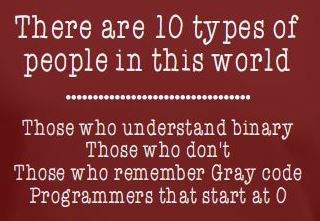Despite having learned about binary arithmetic and ASCII encoding a long time ago, I still sometimes stumble on some of the concepts like big endian and two’s complement. Fortunately, I don’t need to store any of that in my head for instant recall anymore. First, I don’t use binary arithmetic on a regular basis and if I ever have the need, I can just check the Google.
However, that doesn’t mean that I don’t have binary in my head, as evidenced by the image I’ve posted with this article. Instead of useful binary in my head, I go on as such: We classify decimal as base ten. We do that because we have ten fingers and “deci” means “ten” in Latin or Roman or something like that. Ten fingers equal base ten = decimal. That’s cool. But have you ever wondered how clocks can also be considered base ten devices?
Um. What?
Step back a minute with me.
Binary, or base two is called base two, because there are two states instead of 10 (10 for 10 fingers). Zero (0) and one (1) states exist in binary. Now counting in binary is pretty simple:
1d = 1b
2d = 10b
So, two in binary equals 10. Therefore binary, or base 2, can be accurately described as base 10. That still doesn’t explain how I can also call a clock a base 10 device. To do that, take one of your hands and look at it with the palm facing you. Now use your thumb to count each bone in your four non-thumb fingers. You will count 12. That’s how we get 12 hours in the day, or with two hands, 24 hours in day and night.
Counting to ten in clock language
1, 2, 3, 4, 5, 6, 7, 8, 9, A, B, 10.
Sooooo. 12 finger segments. 12 in base 10 is 12, but 12 decimal is equal to 10 base 12. Therefore, the clock has 10 hours in it. Q.E.D.
Enough of that. Now you should get back to the real world and get a quote for your PCB assembly project using our online quote app.
Duane Benson

